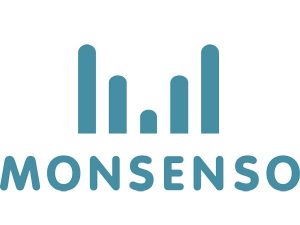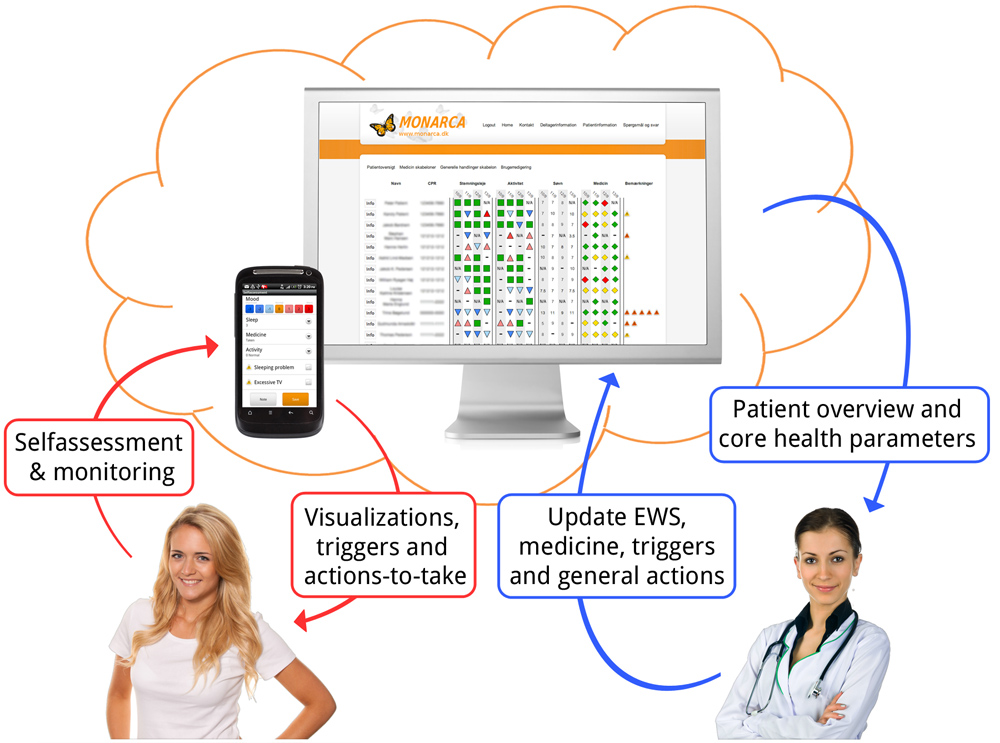The MONARCA project was an EU FP7 STREP project (2010–14) involving 13 partners, including the IT University of Copenhagen and the Psychiatric Center Copenhagen (‘Rigshospitalet’) [1]. The goal was to;
“…develop and validate solutions for multi-parametric, long term monitoring of behavioural and physiological information for bipolar disorder”
The MONARCA System
The MONARCA system [2, 3] is an example of a ‘personal health technology [4]’. The overall goal is to improve the treatment of patients suffering from bipolar disorder. This is done by supporting patients to self-report and collect health data, which can be continuously reviewed by clinicians. We have labelled this socio-technical treatment setup for a ‘double loop’ as illustrated in the figure above [5].
By using this personal smartphone-based healthcare application, the patient is provided with a greater awareness of his or her disease and can exercise a much greater degree of self-care and self-treatment. The system lets the patient self-assess and review a number of health parameters and supports illness management. For example, patients can use the data to determine adherence to medications, investigate illness patterns and identify early warning signs for upcoming affective episodes, or test potentially beneficial behavior changes. Data collected can be used to predict and prevent the relapse of critical episodes. Through monitoring and persuasive feedback, the system helps patients implement effective short-term responses to warning signs and preventive long-term habits. This reduces the need for clinical supervision, treatment, and care, while at the same time empowers the patient in personally dealing with the disease.
The MONARCA system was designed in a user-centered design process called the “Patient-Clinician-Designer (PCD) Framework”, in close collaboration with patients and clinicians [6]. The design is shown in the concept video below.
The MONARCA system implements a sophisticated data collection framework, which collects and classify the following ‘objective’ state markers:
- physical activity
- mobility
- social activity
- phone usage
- voice features
Clinical Studies
The MONARCA system, have been subject to a number of studies. These studies can be divided into three types:
- Usability and usefulness studies
- Mood forecasting studies
- Clinical studies
Usability and usefulness studies
A usability study (N=30) of the MONARCA system found that it had a very high compliance rate of 87% in terms of patients using the system for self-rating on a daily basis; it was considered very useful and very usable by patients and clinicians; patients argued that it helped them better manage their disease; and clinicians agreed that it helped them better manage patients [3]. A second study (N=78) found an adherence rate of 93% [7].
Mood forecasting studies
The MONARCA system collects both subjective (self-assessment) and objective (sensor) features from the patients’ smartphone. Based on this data, we have been building algorithms for predicting a patient’s mood. In a study [8] involving bipolar patients (N=10), we were able to estimate mood values with an average mean absolute error of 0.5 on a mood scale from -3 to +3. This was used to rank the behavior parameters whose variations indicate changes in the mental state. The rankings acquired from our algorithms correspond to the patients’ rankings, identifying ‘physical activity’ and ‘sleep’ as the highest impact parameters. Hence, by just monitoring simple ‘objective’ behavioral features like physical activity and sleep, we can quite accurately classify the mood of a patient.
Clinical studies
A number of clinical studies have been done. All of the clinical studies show that there is a significant correlation between self-rated mood and clinically rated depression and mania [9, 10]. This result indicates that patients are able to assess their own disease and that self-rated mood hence are valid indicators for treatment in the clinic.
The clinical studies also show that there is a significant correlation between ‘social activity’ (as measured in terms of number of in/out-going calls and text messages on the phone) and depression and mania [10], as well as a significant correlation between ‘mobility’ (as measured as roaming between GSM cell towers) and depression and mania [10]. These findings made the clinicians conclude that;
“Smartphone apps represent an easy and objective way to monitor illness activity with real-time data in bipolar disorder and may serve as an electronic biomarker of illness activity.”
In another study (N=28) the smartphone was used to collect voice features (from the phone conversations) in naturalistic everyday settings over 12 weeks. By training a classification algorithm against clinical ratings of mood (HDRS-17 (depression) and YMRS (manic)), we were able to classify depressive and manic state with an accuracy of 70% and 61% respectively. Hence, voice features collected in naturalistic settings using smartphones may be used as objective state markers in patients with bipolar disorder [11].
Finally, we have conducted a randomized clinical trial (RCT) to provide evidence that using the MONARCA system could reduce illness symptoms in patients with bipolar disorder [12]. The study, however, showed no significant effects of daily self-monitoring using the MONARCA system on depressive or manic symptoms [7].
Dissemination & Spin-out
The results of the MONARCA project has been widely disseminated in national Danish media, including:
- Elektronisk monitorering af patienter med bipolar affektiv sindslidelse [13]. Ugeskrift for læger, 2012.
- Ny app kan være guld værd for mennesker med psykisk sygdom. Region Hovedstaden, 2012.
- Få psykiatrisk hjælp fra din smartphone. Københavns Universitet, 2016
- Apps og smartphone-data er den nye medicin. Dansk Psykolog Forening, 2018.
 In 2014, the company Monsenso was founded by the researchers in the MONARCA project. Monsenso now provides a complete mHealth solution for mental health covering most types of mental health diseases.
In 2014, the company Monsenso was founded by the researchers in the MONARCA project. Monsenso now provides a complete mHealth solution for mental health covering most types of mental health diseases.
References
![[pdf]](https://www.bardram.net/wp-content/plugins/papercite/img/pdf.png)
[Bibtex]
@article{gravenhorst2015:mobile,
year={2015},
issn={1617-4909},
journal={Personal and Ubiquitous Computing},
volume={19},
number={2},
doi={10.1007/s00779-014-0829-5},
title={Mobile phones as medical devices in mental disorder treatment: an overview},
url={http://dx.doi.org/10.1007/s00779-014-0829-5},
publisher={Springer London},
keywords={Mobile phone; Medical device; Mental disorder},
author={Gravenhorst, Franz and Muaremi, Amir and Bardram, Jakob E. and Gr{\"u}nerbl, Agnes and Mayora, Oscar and Wurzer, Gabriel and Frost, Mads and Osmani, Venet and Arnrich, Bert and Lukowicz, Paul and Tr{\"o}ster, Gerhard},
pages={335-353},
language={English},
pdf = {Mobile_Phones_as_Medical_Devices_in_Mental_Disorder_Treatment_PUC.pdf},
tag = {journal,monarca},
}![[pdf]](https://www.bardram.net/wp-content/plugins/papercite/img/pdf.png)
[Bibtex]
@inproceedings{ihi2012:bardram,
author = {Bardram, Jakob E. and Frost, Mads and Szanto, Karoly and Marcu, Gabriela},
title = {The MONARCA self-assessment system: a persuasive personal monitoring system for bipolar patients},
booktitle = {Proceedings of the 2nd ACM SIGHIT International Health Informatics Symposium},
series = {IHI '12},
year = {2012},
isbn = {978-1-4503-0781-9},
location = {Miami, Florida, USA},
pages = {21--30},
numpages = {10},
url = {http://doi.acm.org/10.1145/2110363.2110370},
doi = {10.1145/2110363.2110370},
acmid = {2110370},
publisher = {ACM},
address = {New York, NY, USA},
keywords = {android, bipolar disorder, mental illness management, personal monitoring systems, self-assessment},
tag={monarca,conference},
pdf={IHI2012-bardram.pdf}
}![[pdf]](https://www.bardram.net/wp-content/plugins/papercite/img/pdf.png)
[Bibtex]
@inproceedings{chi2013:bardram,
author = {Bardram, Jakob E. and Frost, Mads and Szanto, Karoly and Faurholt-Jepsen, Maria and Vinberg, Maj and Kessing, Lars Vedel},
title = {Designing mobile health technology for bipolar disorder: a field trial of the monarca system},
booktitle = {Proceedings of the SIGCHI Conference on Human Factors in Computing Systems},
series = {CHI '13},
year = {2013},
isbn = {978-1-4503-1899-0},
location = {Paris, France},
pages = {2627--2636},
numpages = {10},
url = {http://doi.acm.org/10.1145/2470654.2481364},
doi = {10.1145/2470654.2481364},
acmid = {2481364},
publisher = {ACM},
address = {New York, NY, USA},
keywords = {bipolar disorder, mental health, mobile application, personal health systems},
tag={monarca,conference},
}![[pdf]](https://www.bardram.net/wp-content/plugins/papercite/img/pdf.png)
[Bibtex]
@article{bardram2016personal,
author = {Bardram, Jakob E. and Frost, Mads},
journal = {IEEE Pervasive Computing},
number = {2},
pages = {70--78},
publisher = {IEEE},
title = {{The Personal Health Technology Design Space}},
volume = {15},
year = {2016},
month={Apr},
doi={10.1109/MPRV.2016.37},
ISSN={1536-1268},
}[Bibtex]
@incollection{Bardram2018167,
title = "Chapter 10 - Double-Loop Health Technology: Enabling Socio-technical Design of Personal Health Technology in Clinical Practice ",
editor = "Ackerman, Mark S. and Goggins, Sean P. and Herrmann, Thomas and Prilla, Michael and Stary, Christian ",
booktitle = "Designing Healthcare That Works ",
publisher = "Academic Press",
edition = "",
address = "",
year = "2018",
pages = "167 - 186",
isbn = "978-0-12-812583-0",
doi = "https://doi.org/10.1016/B978-0-12-812583-0.00010-9",
url = "https://www.sciencedirect.com/science/article/pii/B9780128125830000109",
author = "Jakob E. Bardram and Mads M. Frost",
keywords = "Double-loop",
keywords = "Mental health",
keywords = "MONARCA",
keywords = "Noncommunicable diseases",
keywords = "Personal health technology",
keywords = "Socio-technical design "
}![[pdf]](https://www.bardram.net/wp-content/plugins/papercite/img/pdf.png) G. Marcu, J. E. Bardram, and S. Gabrielli, “A Framework for Overcoming Challenges in Designing Persuasive Monitoring Systems for Mental Illness,” in Proceedings of Pervasive Health 2011, 2011, p. 1–10.
G. Marcu, J. E. Bardram, and S. Gabrielli, “A Framework for Overcoming Challenges in Designing Persuasive Monitoring Systems for Mental Illness,” in Proceedings of Pervasive Health 2011, 2011, p. 1–10. [Bibtex]
@inproceedings{pervasivehealth2011:marcu,
author = {Marcu, G. and Bardram, J. E. and Gabrielli, S},
title = {A Framework for Overcoming Challenges in Designing Persuasive Monitoring Systems for Mental Illness},
booktitle = {Proceedings of Pervasive Health 2011},
location = {Dublin, Ireland},
year = {2011},
pages = {1--10},
publisher = {IEEE Press},
tag={phc,monarca,conference},
pdf={monarca.PervasiveHealth11.cameraready.pdf},
}![[pdf]](https://www.bardram.net/wp-content/plugins/papercite/img/pdf.png) M. Faurholt-Jepsen, M. Frost, C. Ritz, E. M. Christensen, A. Jacoby, R. Mikkelsen, U. Knorr, J. Bardram, M. Vinberg, and L. V. Kessing, “Daily electronic self-monitoring in bipolar disorder using smartphones–the MONARCA I trial: a randomized, placebo-controlled, single-blind, parallel group trial,” Psychological medicine, vol. 45, iss. 13, p. 2691–2704, 2015.
M. Faurholt-Jepsen, M. Frost, C. Ritz, E. M. Christensen, A. Jacoby, R. Mikkelsen, U. Knorr, J. Bardram, M. Vinberg, and L. V. Kessing, “Daily electronic self-monitoring in bipolar disorder using smartphones–the MONARCA I trial: a randomized, placebo-controlled, single-blind, parallel group trial,” Psychological medicine, vol. 45, iss. 13, p. 2691–2704, 2015. [Bibtex]
@article{faurholt2015daily,
title={Daily electronic self-monitoring in bipolar disorder using smartphones--the MONARCA I trial: a randomized, placebo-controlled, single-blind, parallel group trial},
author={Faurholt-Jepsen, Maria and Frost, Mads and Ritz, Christian and Christensen, Ellen Margrethe and Jacoby, AS and Mikkelsen, RL and Knorr, U and Bardram, JE and Vinberg, Maj and Kessing, Lars Vedel},
journal={Psychological medicine},
volume={45},
number={13},
pages={2691--2704},
year={2015},
publisher={Cambridge University Press}
}![[pdf]](https://www.bardram.net/wp-content/plugins/papercite/img/pdf.png)
[Bibtex]
@article{doryab2015:impact,
year={2015},
issn={1617-4909},
journal={Personal and Ubiquitous Computing},
volume={19},
number={2},
doi={10.1007/s00779-014-0826-8},
title={Impact factor analysis: combining prediction with parameter ranking to reveal the impact of behavior on health outcome},
url={http://dx.doi.org/10.1007/s00779-014-0826-8},
publisher={Springer London},
keywords={Health and behavior; Machine learning; Mental health; Bipolar disorder},
author={Doryab, Afsaneh and Frost, Mads and Faurholt-Jepsen, Maria and Kessing, Lars V. and Bardram, Jakob E.},
pages={355-365},
language={English},
pdf = {2014.PUC.Impact.Factor.Analysis.pdf},
tag = {journal,monarca},
}[Bibtex]
@article{faurholt2015smartphone,
title={Smartphone Data as an Electronic Biomarker of Illness Activity in Bipolar Disorder},
author={Faurholt-Jepsen, M and Vinberg, M and Frost, M and Christensen, EM and Bardram, JE and Kessing, LV},
journal={European Psychiatry},
volume={30},
pages={226},
year={2015},
publisher={Elsevier Masson},
pdf={},
tag={journal,monarca},
}[Bibtex]
@article{faurholt2016behavioral,
title={Behavioral activities collected through smartphones and the association with illness activity in bipolar disorder},
author={Faurholt-Jepsen, Maria and Vinberg, Maj and Frost, Mads and Debel, Sune and Margrethe Christensen, Ellen and Bardram, Jakob E and Kessing, Lars Vedel},
journal={International Journal of Methods in Psychiatric Research},
year={2016},
publisher={Wiley Online Library},
doi={10.1002/mpr.1502},
pdf={},
tag={journal,monarca},
}![[pdf]](https://www.bardram.net/wp-content/plugins/papercite/img/pdf.png)
[Bibtex]
@article{Faurholt-Jepsen2016,
abstract = {Changes in speech have been suggested as sensitive and valid measures of depression and mania in bipolar disorder. The present study aimed at investigating (1) voice features collected during phone calls as objective markers of affective states in bipolar disorder and (2) if combining voice features with automatically generated objective smartphone data on behavioral activities (for example, number of text messages and phone calls per day) and electronic self-monitored data (mood) on illness activity would increase the accuracy as a marker of affective states. Using smartphones, voice features, automatically generated objective smartphone data on behavioral activities and electronic self-monitored data were collected from 28 outpatients with bipolar disorder in naturalistic settings on a daily basis during a period of 12 weeks. Depressive and manic symptoms were assessed using the Hamilton Depression Rating Scale 17-item and the Young Mania Rating Scale, respectively, by a researcher blinded to smartphone data. Data were analyzed using random forest algorithms. Affective states were classified using voice features extracted during everyday life phone calls. Voice features were found to be more accurate, sensitive and specific in the classification of manic or mixed states with an area under the curve (AUC)=0.89 compared with an AUC=0.78 for the classification of depressive states. Combining voice features with automatically generated objective smartphone data on behavioral activities and electronic self-monitored data increased the accuracy, sensitivity and specificity of classification of affective states slightly. Voice features collected in naturalistic settings using smartphones may be used as objective state markers in patients with bipolar disorder.},
author = {Faurholt-Jepsen, M and Busk, J and Frost, M and Vinberg, M and Christensen, E M and Winther, O and Bardram, J E and Kessing, L V},
Journal = {Transl Psychiatry},
month = jul,
pages = {e856},
publisher = {Macmillan Publishers Limited},
title = {{Voice analysis as an objective state marker in bipolar disorder}},
url = {http://dx.doi.org/10.1038/tp.2016.123 10.1038/tp.2016.123},
doi={10.1038/tp.2016.123},
volume = {6},
year = {2016}
}![[pdf]](https://www.bardram.net/wp-content/plugins/papercite/img/pdf.png) M. Faurholt-Jepsen, M. Vinberg, E. M. Christensen, M. Frost, J. E. Bardram, and L. V. Kessing, “Daily electronic self-monitoring of subjective and objective symptoms in bipolar disorder – The MONARCA trial protocol (MONitoring, treAtment and pRediCtion of bipolAr disorder episodes): a randomised controlled single-blind trial,” BMJ open, vol. 3, iss. 7, 2013.
M. Faurholt-Jepsen, M. Vinberg, E. M. Christensen, M. Frost, J. E. Bardram, and L. V. Kessing, “Daily electronic self-monitoring of subjective and objective symptoms in bipolar disorder – The MONARCA trial protocol (MONitoring, treAtment and pRediCtion of bipolAr disorder episodes): a randomised controlled single-blind trial,” BMJ open, vol. 3, iss. 7, 2013. [Bibtex]
@article{faurholt2013daily,
title={Daily electronic self-monitoring of subjective and objective symptoms in bipolar disorder - The MONARCA trial protocol (MONitoring, treAtment and pRediCtion of bipolAr disorder episodes): a randomised controlled single-blind trial},
author={Faurholt-Jepsen, Maria and Vinberg, Maj and Christensen, Ellen Margrethe and Frost, Mads and Bardram, Jakob E and Kessing, Lars Vedel},
journal={BMJ open},
volume={3},
number={7},
year={2013},
publisher={British Medical Journal Publishing Group},
url={http://bmjopen.bmj.com/content/3/7/e003353.short},
tag={monarca,journal},
pdf={faurholt-jepsen.bmj.pdf},
}![[pdf]](https://www.bardram.net/wp-content/plugins/papercite/img/pdf.png) A. S. Jacoby, M. Faurholt-Jepsen, M. Vinberg, M. Frost, J. Bardram, and L. V. Kessing, “Elektronisk monitorering af patienter med bipolar affektiv sindslidelse,” Ugeskrift for læger, vol. 174, iss. 44, pp. 2707-2710, 2012.
A. S. Jacoby, M. Faurholt-Jepsen, M. Vinberg, M. Frost, J. Bardram, and L. V. Kessing, “Elektronisk monitorering af patienter med bipolar affektiv sindslidelse,” Ugeskrift for læger, vol. 174, iss. 44, pp. 2707-2710, 2012. [Bibtex]
@article{jacoby:2012:ugeskriftet,
Title = {Elektronisk monitorering af patienter med bipolar affektiv sindslidelse},
Author = {Anne Sophie Jacoby and Maria Faurholt-Jepsen and Maj Vinberg and Mads Frost and Jakob Bardram and Lars Vedel Kessing},
Journal = {Ugeskrift for l{\ae}ger},
Year = {2012},
Volume = {174},
Number = {44},
Pages = {2707-2710},
url = {http://ugeskriftet.dk/videnskab/elektronisk-monitorering-af-patienter-med-bipolar-affektiv-sindslidelse},
tag={monarca,journal},
pdf={artikel_3177.pdf},
}
